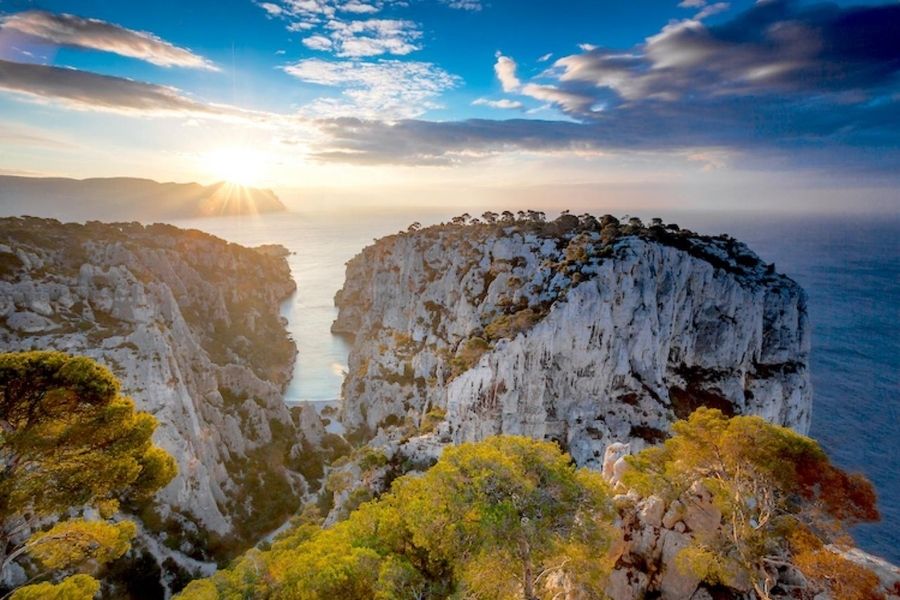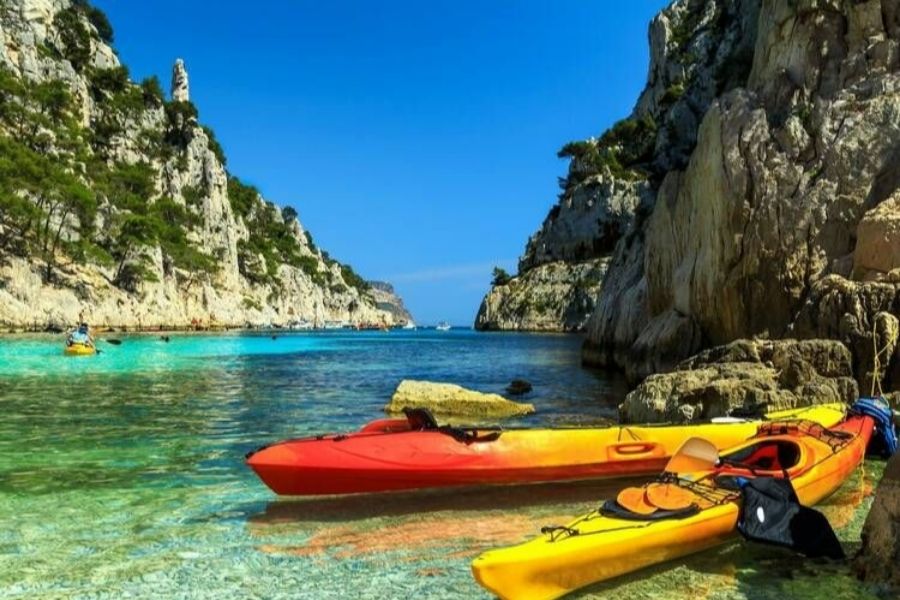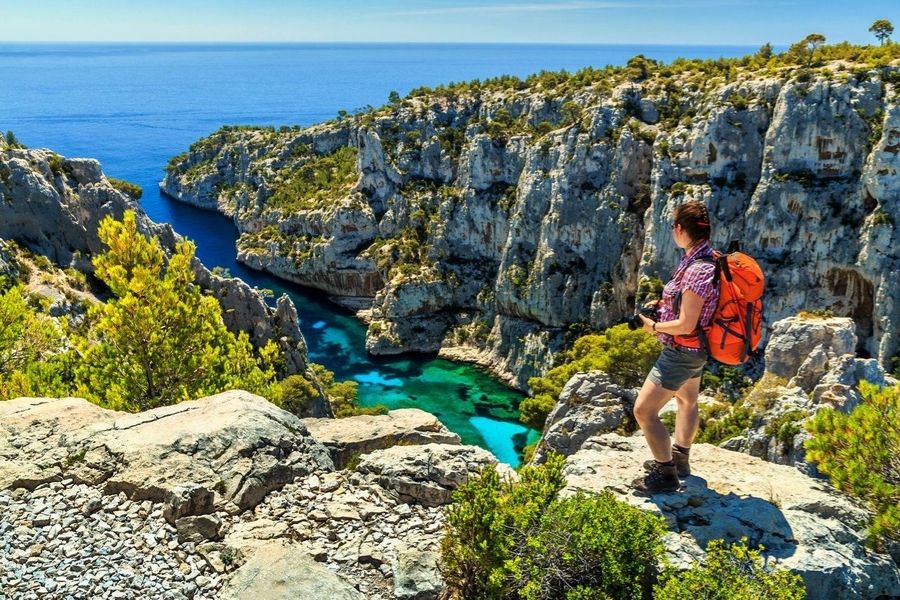Ever dreamed of hiking along dramatic cliffs with the Mediterranean sparkling below? The Calanques National Park near Marseille really should be at the top of your travel list. Tucked between Marseille and La Ciotat, the park blends limestone fjords, turquoise coves, and scenery that honestly feels like a secret side of Provence.
As I walked there, I kept stopping just to stare at the sheer white cliffs dropping into that deep blue water. It’s the kind of place you see on postcards and wonder if it really exists.
My time in the Calanques turned into a true adventure. I found scenic trails, hidden beaches, and views that almost didn’t seem real. This park isn’t just beautiful—it’s perfect for anyone who loves hiking, wild nature, and a bit of escape from the usual tourist crowds.

From quiet moments in the hills to the fresh coastal air, I kept finding new reasons to fall in love with this corner of southern France. Whether you’re a seasoned hiker or just want a unique adventure, the Calanques give you a taste of Provence’s wild side.
Discovering Calanques National Park: Limestone Wonders & Turquoise Waters
Hidden along Provence’s southern coast, Calanques National Park pulled me in with its sheer limestone cliffs and peaceful, turquoise bays. From dramatic natural sculptures to quiet coves, every part of the park gave me something to remember.
Geography and Formation of the Calanques
The Calanques stretch between Marseille and Cassis, hugging the Mediterranean. Their rugged coastline looks nothing like anywhere else I’ve explored. The park covers more than 500 square kilometers, with both land and sea included.
Steep, narrow inlets cut deep into the white limestone give the Calanques their name. Over millions of years, water erosion and tectonic shifts carved out these fjord-like valleys.
The chalk-white rock against the blue sea is just jaw-dropping. Sometimes, walking here felt like stepping into another world—one shaped by ancient forces.
The Unique Beauty of Limestone Fjords
The Calanques’ limestone sets them apart, even among Provence’s famous sights. The cliffs soar above the sea, their rough, bright faces catching the sun.
I loved how the light bounced off the rock, making everything glow in soft, golden tones as the day went on. The limestone erodes into weird and wonderful shapes—arches, caves, and sheer walls that draw hikers and climbers from everywhere.

Aleppo pines and garrigue bushes somehow cling to the cliffs, adding splashes of green to all that white stone. This contrast made for endless photo ops—I barely put my camera down.
Turquoise Coves and Iconic Vistas
Tucked between the cliffs, the Calanques hold quiet coves, each with its own vibe. The water in these inlets looks impossibly clear and blue, shifting from turquoise to deep indigo as the light changes.
Some coves, like Calanque d’En-Vau and Calanque de Sormiou, take a bit of effort to reach, but wow, they’re worth it. I swam, picnicked, or just watched boats drift by.
What really stuck with me were the views from the trails above—limestone meeting water in bold, sharp lines. Looking out over the sea, I felt both peaceful and excited, always curious where the next path would lead.
Planning Your Hike: Essential Tips and Routes
Exploring Calanques National Park can be an amazing adventure—sparkling turquoise water, dramatic limestone cliffs, and quiet coves. Picking the right season, knowing the trails, and packing well made my trip so much easier.
Best Time to Visit the Calanques
The Calanques stay open all year, but each season changes the hiking experience. Spring (April to June) turned out to be my favorite: mild weather, wildflowers everywhere. Fall (September to early November) brings cooler temps and fewer people, which is great if you want quiet trails.
Summers in Marseille get hot and crowded, and some trails close because of fire risk. If you go between June and September, start early. Winter hikes feel peaceful, but rain makes some trails slippery. I always check the park’s official site before heading out to see if anything’s closed.
Top Hiking Trails and Difficulty Levels
Calanques National Park has trails for every level, from easy strolls to tough climbs. The Calanque de Sugiton trail is a favorite of mine and great for beginners or families. It takes about two hours round trip, with crystal-clear swimming spots at the end.

If you want a bit more of a challenge, try the path to Calanque d’En-Vau. It’s longer and more rugged—plan for about four hours round-trip, with some steep bits before you reach a gorgeous turquoise cove. For experienced hikers, the GR 98-51 trail links Marseille to Cassis. It’s a full-day, strenuous hike, but the Mediterranean views make every step worth it.
| Trail Name | Difficulty | Estimated Time | Highlights |
|---|---|---|---|
| Calanque de Sugiton | Easy | 2 hrs RT | Swimming, views |
| Calanque d’En-Vau | Moderate | 4 hrs RT | Hidden cove, limestone |
| GR 98-51 | Difficult | 8+ hrs RT | Coastal vistas, variety |
What to Pack for a Calanques Adventure
I learned fast that packing light but smart really matters. Bring plenty of water—at least 1.5 liters per person, especially if it’s warm. There aren’t any shops or water fountains on the trails.
Wear sturdy shoes. The paths can get rocky and steep in spots. Dress in layers: mornings start cool, but it heats up quickly. I always bring a hat, sunscreen, and sunglasses because that sun is no joke.
If you plan to swim, pack a swimsuit and towel. For safety, I toss in a basic first aid kit, a map (offline or printed), and a fully charged phone. Snacks like nuts and fruit keep me going on longer hikes.
A light backpack and a small bag for trash help keep the park clean for everyone.
Immersive Experiences: My Personal Journey Through Marseille’s Calanques
The morning sun warmed Marseille’s stone streets as I set out for Calanques National Park. This place is famous for its limestone cliffs, hidden beaches, and Mediterranean blue coves that almost don’t look real. Every step brought fresh views and a bigger sense of adventure.
Setting Out from Marseille: First Impressions
Leaving the busy city behind, I took a quick trip to the park’s trailhead near Luminy. The scenery changed instantly—city noise faded, replaced by cicadas and distant waves. Pine scents mixed with salty air.
I followed well-marked trails winding through thick scrub and rocky ground. As the path climbed, glimpses of turquoise sea peeked through tall grass. That first view of the calanques’ white cliffs against the water? Unforgettable.

Locals and travelers mixed on the trail, swapping tips and smiles. Even early on, I felt a strong connection to nature.
Highlights and Hidden Gems Along the Trails
Classic routes—like those to Calanque de Sugiton and Calanque de Morgiou—show off the best of the park. Sugiton’s trail winds through shady pine forests, then opens to a stunning amphitheater of cliffs and sea. I stopped at a small rocky beach for a swim; the water was clear and surprisingly cool.
Some favorite trail highlights:
- Hidden swimming coves: Quiet places to cool off and relax.
- Wildlife sightings: Birds, butterflies, and even a quick lizard.
- Panoramic ledges: Great photo spots, away from the crowds.
Some areas feel remote, even though Marseille isn’t far away. Friendly hikers often pointed me to quieter paths or secret grottos. Every turn brought a new surprise, making it clear why locals and visitors both love this place.
Breathtaking Overlooks and Picnic Spots
At the higher viewpoints, I found natural terraces carved into the cliffs. These overlooks made perfect impromptu picnic spots, with wide views over turquoise bays and the occasional fishing boat drifting by.
I ate a simple lunch—fresh bread, local cheese, olives—on sun-warmed stone, the sea stretching out below. A few benches and shaded rocks offered great places to rest.
From Calanque d’En-Vau’s dramatic perch, the drop to the water looked dizzying. These overlooks weren’t just for the views; they were places to slow down and soak in Provence’s unique spirit. Even in busy months, I found quiet corners to enjoy the moment and think about the journey so far.
Beyond the Fjords: Provençal Culture, Food, and Traditions
Exploring Calanques National Park was just the start. In the villages around Marseille, old customs and amazing food brought a whole new flavor to my trip.
Culinary Delights: Cheese, Wine, and Local Flavors
Wandering through Provence’s markets, I found wheels of creamy goat cheese, tangy Tomme, and herbed chèvre. The cheese tastes best with crusty bread and a drizzle of local olive oil—people here really care about their food.
Wine tasting here is its own adventure. Provence is famous for its rosé, but I also tried reds from the Rhône and crisp whites from Sancerre. A friendly café owner explained terroir—how the soil and sun shape each wine’s flavor. For variety, I sampled bottles from Bordeaux, Champagne, Alsace, and the Loire Valley. Even a light Beaujolais paired perfectly with smoked sausage.

Must-try local dishes:
- Bouillabaisse (fish stew)
- Tapenade (olive spread)
- Socca (chickpea pancake)
Cultural Encounters and Provençal Hospitality
In a shady Cassis square, I watched a game of pétanque while families laughed nearby. Locals are proud of their traditions but happy to welcome visitors. At small bakeries, I chatted with people about neighborhood festivals and old folk stories.
Hospitality here feels personal. Winemakers in Bourgueil and Chinon invited me into cool cellars for tastings, sharing their knowledge and family tales. At the village market, an older woman taught me to greet people with a cheerful “bonjour” and a kiss on each cheek.
These little moments—over wine, cheese, or stories—made me feel at home in a place where tradition still shapes daily life.
How the Calanques Compare: French Destinations for Nature Lovers
France is packed with natural wonders, and honestly, the Calanques hold their own next to the country’s most famous landscapes. Adventure, active travel, and moments that feel straight out of a novel? You can find them all, from mountain peaks to scenic bike routes.
From the French Alps to the Pyrenees: Similar Adventures
Hiking in the Calanques feels unique, but I can’t help comparing those white limestone cliffs and hidden coves to the wild beauty of the French Alps and the Pyrenees. Both mountain ranges pull in hikers with breathtaking trails and challenging climbs.
Honestly, the views just stop you in your tracks. In the French Alps, I remember breathing in crisp air near glacier lakes and feeling tiny next to Mont Blanc. That’s the highest peak in Western Europe, by the way.
The Pyrenees, straddling the border with Spain, feel like a rugged escape. Fewer tourists wander there, so there’s this rare calm.
Traditional mountain villages dot the landscape. Wildflowers pop up everywhere, and if you’re lucky, you might spot marmots or even eagles.

The Alps and Pyrenees trade the Calanques’ sun for alpine drama—snowy peaks, deep forests, and rivers that really roar after the snow melts. You can reach each region by public transport.
Both areas offer well-marked hiking routes, whether you’re up for a day trip or a whole week on the trails. If you love the outdoors, these places are honestly hard to beat.
Exploring by Bicycle: Alternative Active Journeys
Hiking brings you close to the Calanques’ secret corners, but exploring France by bicycle? That’s a whole different rush.
When I pedal along coastal paths or winding mountain roads, I get to take in the landscape at my own speed. Sometimes I just stop and stare.
Bicycle routes like the Vélo Francette—or even parts of the famous Tour de France—run through towns packed with history and personality. In Provence, not far from Marseille, vineyards and lavender fields seem to go on forever.
The Loire Valley routes aren’t as wild as the Calanques, but castles and river views somehow make every kilometer feel rewarding.
Biking gives me freedom. I can pause in little villages for fresh bread, chat with locals, and stumble onto places I’d never find by car or train.
Whether you’re chasing a challenge or just want to take it easy, France really rolls out the welcome mat for cyclists.
Literary Inspirations: My Own Moveable Feast
As I wandered the Calanques, I honestly felt like I’d stumbled right into the pages of a book. There’s something about travel in France—it always brings Hemingway’s A Moveable Feast to mind.
Every new place seems to add a little something to my own story. Writers like Colette and Camus found inspiration in the ever-changing French landscape, and I get why.
The shimmering blue waters around Marseille made me stop, notebook in hand, just trying to capture the light. Sometimes I wonder if anyone can ever really describe it.
When I’m hiking in the mountains or tracing city streets on a bicycle, those moments shape my travels in ways I never expect. The Calanques mix wild beauty with possibility.
It’s a kind of personal “moveable feast” I end up carrying with me, long after I’ve left.

